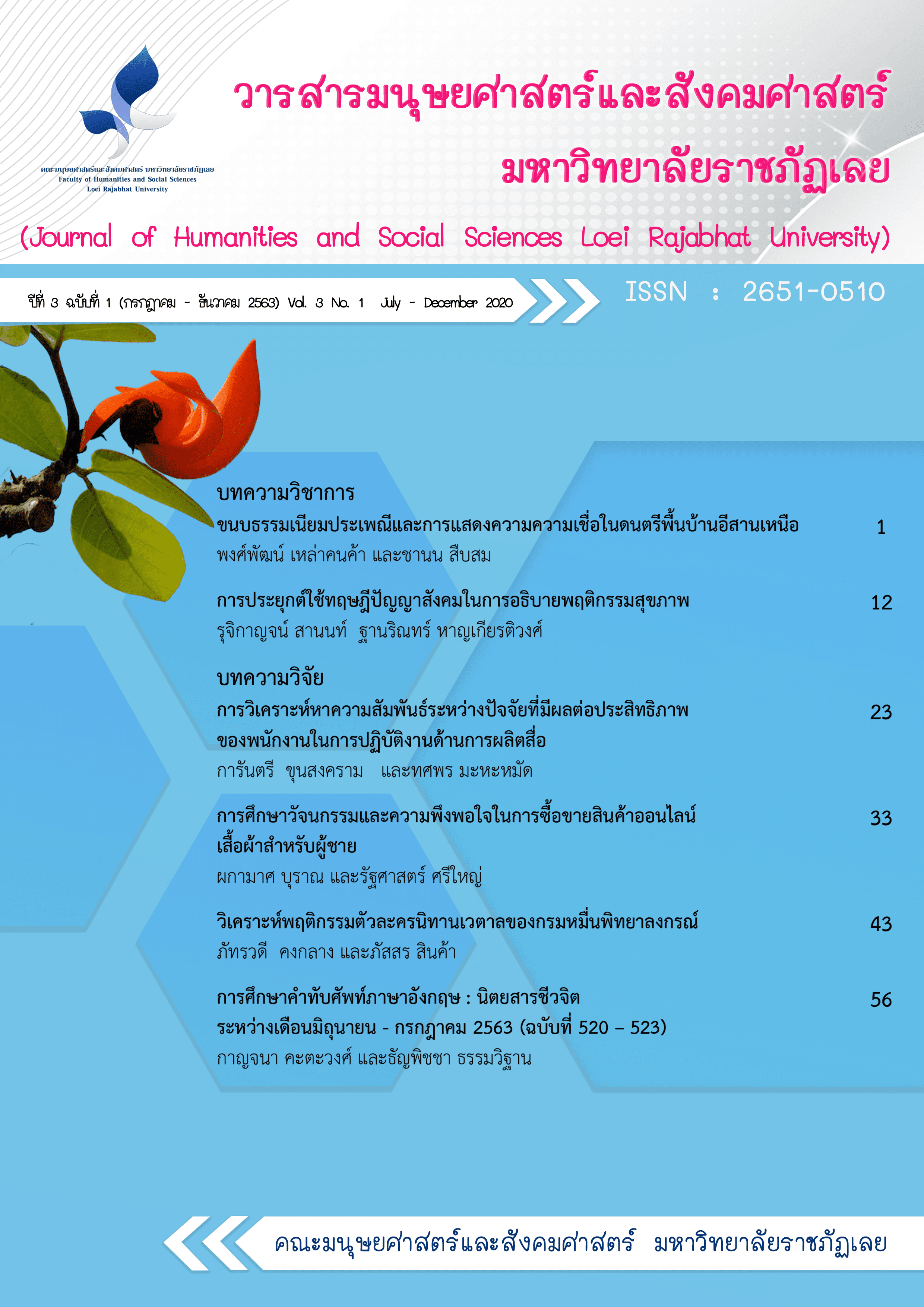Application of Social Cognitive Theory to Explain Health Behavior
Keywords:
social cognitive theory, health behaviorsAbstract
This academic article aims to explain the concept of social cognitive theory in applying to study health behavior. By explaining the basic concept, the source of the theory is self-awareness Self-Efficacy and Self-Regulation to give examples of concepts used to describe behavior and examples of models used to describe physical health behaviors.
References
จักรพันธ์ เพ็ชรภูมิ. (2561). พฤติกรรมสุขภาพ แนวคิด ทฤษฎี และการประยุกต์ใช้, (พิมพ์ครั้งที่ 2), พิษณุโลก: สำนักพิมพ์มหาวิทยาลัยนเรศวร. 292.
อาภาพร เผ่าวัฒนา, สุรินธร กลัมพาพร, สุนีย์ ละกำปั่น และขวัญใจ อำนาจสัตย์ซื่อ. (2554). การสร้างเสริมสุขภาพและป้องกันโรคในชุมชน: การประยุกต์แนวคิดและทฤษฎีสู่การปฏิบัติ, ขอนแก่น: หจก.โรงพิมพ์คลังนานาวิทยา.
Bandura, A. (Ed.). (1995). Self-efficacy in changing societies. Cambridge university press
Bandura, A. (2004). Health promotion by social cognitive means. Health education & behavior, 31(2), 143-164.
Davies, M., & Macdowall, W. (2006). Health promotion theory. Open University Press.
Gochman, D. S. (1997). Health behavior research: Definitions and diversity. Handbook of health behavior research, 1, 5-34.
Hopkins, D. P., Briss, P. A., Ricard, C. J., Husten, C. G., Carande-Kulis, V. G., Fielding, J. E., ... & Woollery, T. A. (2001). Reviews of evidence regarding interventions to reduce tobacco use and exposure to environmental tobacco smoke. American journal of preventive medicine, 20(2), 16-66.
Lorig, K. R., Ritter, P., Stewart, A. L., Sobel, D. S., Brown Jr, B. W., Bandura, A., & Holman, H. R. (2001). Chronic disease self-management program: 2-year health status and health care utilization outcomes. Medical care, 1217-1223.
Loukas, A., Spaulding, C., & Gottlieb, N. H. (2006). Examining the perspectives of Texas minors cited for possession of tobacco. Health promotion practice, 7(2), 197-205.
Maibach, E., Flora, J. A., & Nass, C. (1991). Changes in self-efficacy and health behavior in response to a minimal contact community health campaign. Health Communication, 3(1), 1-15.
McAlister, A., Johnson, W., Guenther-Grey, C., Fishbein, M., Higgins, D., & O'Reilly, K. (2000). Behavioral journalism for HIV prevention: Community newsletters influence risk-related attitudes and behavior. Journalism & Mass Communication Quarterly, 77(1), 143-159.
McAlister, A. L., Perry, C. L., & Parcel, G. S. (2008). How individuals, environments, and health behaviors interact. Health Behavior, 169.
Pender, N. J., Murdaugh, C. L., & Parsons, M. A. (2015). Health promotion in nursing practice, (seventh edition), New Jersey, Peason Education, Inc
Perry, C. L., Williams, C. L., Komro, K. A., Veblen-Mortenson, S., Forster, J. L., Bernstein-Lachter, R., & Finnegan, J. (2000). Project Northland high school interventions: Community action to reduce adolescent alcohol use. Health Education & Behavior, 27(1), 29-49.
Rabius, V., McAlister, A. L., Geiger, A., Huang, P., & Todd, R. (2004). Telephone counseling increases cessation rates among young adult smokers. Health Psychology, 23(5), 539.
Sherman, S. G., German, D., Cheng, Y., Marks, M., & Bailey-Kloche, M. (2006). The evaluation of the JEWEL project: an innovative economic enhancement and HIV prevention intervention study targeting drug using women involved in prostitution. AIDS care, 18(1), 1-11.
Singhal, A., and Rogers. (1999). E. A. Entertainment-Education: A Communication Strategy for Social Change. Hillsdale, N.J.: Erlbaum.
World Health Organization. (1986). Ottawa charter for health promotion. Health promotion, 1, iii-v.
Downloads
Published
Versions
- 2023-02-27 (2)
- 2020-12-10 (1)









